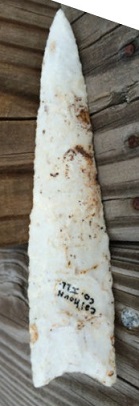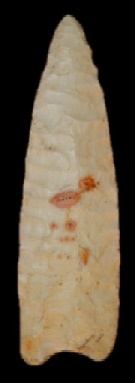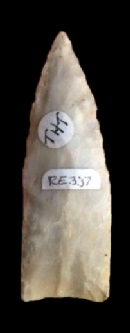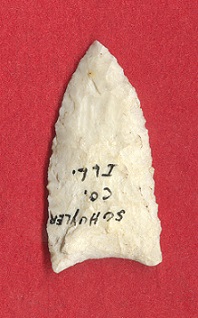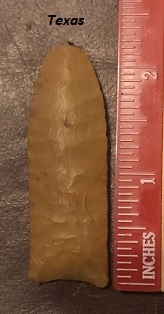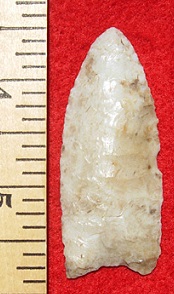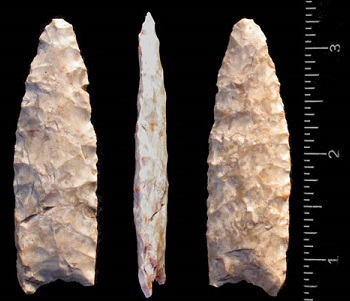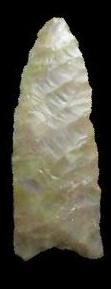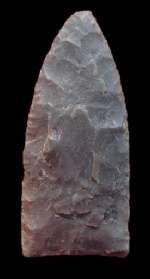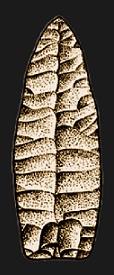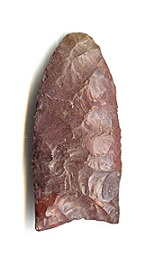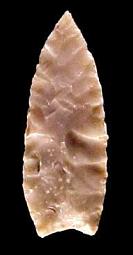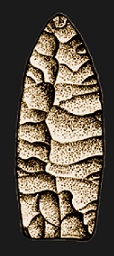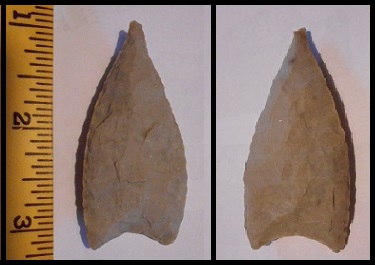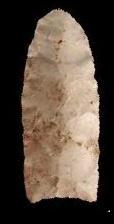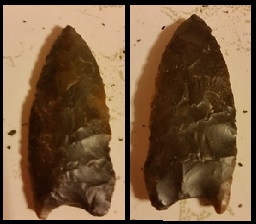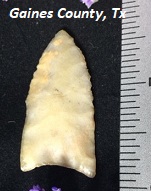Outline is Representative of Size and Shape:

Name Details:
Identified By: Elisa H. Sellards, Glen L. Evans and Grayson E. Meade
Named For: Type Site
Date Identified: 1947
Type Site: Plainview Site (near Plainview Texas), Running Water Draw, Hale County, Texas
Identified By: Elisa H. Sellards, Glen L. Evans and Grayson E. Meade
Named For: Type Site
Date Identified: 1947
Type Site: Plainview Site (near Plainview Texas), Running Water Draw, Hale County, Texas
Point Validity:
Valid type
Sellards was a paleontologist who became interested in the fossil remains of the Berclair Terrace in Bee County Texas. He conducted many excavations and became influential in Texas archaeology. Evans was a geologist, and Mead was a paleontologist and a geologist. All were professors at the Texas Tech University and conducted studies on the Beclair Terrace. This point was named in a professional publication and has many processional references. This is considered a valid type.
Sellards was a paleontologist who became interested in the fossil remains of the Berclair Terrace in Bee County Texas. He conducted many excavations and became influential in Texas archaeology. Evans was a geologist, and Mead was a paleontologist and a geologist. All were professors at the Texas Tech University and conducted studies on the Beclair Terrace. This point was named in a professional publication and has many processional references. This is considered a valid type.
Plainview Lanceolate
AKA: Coastview (Texas)Cluster: Plano Lanceolate Cluster
Description of Physical Characteristics and Flaking Pattern:
This is a medium to large (typically 2.5 to 3.5 inches) lanceolate point with a flattened to elliptical or median ridge cross section. Some cruder examples have had a median ridge. The blade is primarily excurvate towards the tip and parallel sides. The bottom portion of the blade is primarily straight, but may be slightly auriculate on some examples. The top portion of the blade may turn inward forming an abrupt tip. The base may vary from slightly to deeply concave. Grinding of the basal edge and hafting region is commonly seen with long basal thinning flakes. This point is formed using percussion flaking to rough out the preform, then well controlled pressure flaking forming a flaking pattern that may vary from transverse parallel to collateral.
Size Measurements:
Total Length - 45 to 95 mm, Blade Width - 18 to 28 mm, Base Width - 20 to 26 mm, Basal Concavity - 1 to 8 mm (Suhm and Krieger, 1954).
Total Length - 45 to 95 mm, Blade Width - 18 to 28 mm, Base Width - 20 to 26 mm, Basal Concavity - 1 to 8 mm (Suhm and Krieger, 1954).
Commonly Utilized Material:
Additional Comments:
This point is related to the western bison hunting tradition (Justice, 1987).
At Lake Theo site, these points were found between the Folsom and Archaic deposits (Justice, 1987).
These points are thought to be related to the Dalton points (Justice, 1987).
Joel D. Gunn (1984) identified points at Fort Polk Texas that he named the Coastview point. These points were identified as Plainview and the name Coastview has been suggested to be discontinued (Anderson et al. 2002).
These points are similar to Goshen points, but Goshen points are thought to be an older type point (Boszhardt, 2003).
This point is related to the western bison hunting tradition (Justice, 1987).
At Lake Theo site, these points were found between the Folsom and Archaic deposits (Justice, 1987).
These points are thought to be related to the Dalton points (Justice, 1987).
Joel D. Gunn (1984) identified points at Fort Polk Texas that he named the Coastview point. These points were identified as Plainview and the name Coastview has been suggested to be discontinued (Anderson et al. 2002).
These points are similar to Goshen points, but Goshen points are thought to be an older type point (Boszhardt, 2003).
Distribution:

Distribution Comments:
This point is commonly found on the plains from Texas to Alberta. This point is found with less frequency in the highlighted areas outside the plains region. This type has been reported into Mexico Valley and Tehuacan Valley of Mexico.
This point is commonly found on the plains from Texas to Alberta. This point is found with less frequency in the highlighted areas outside the plains region. This type has been reported into Mexico Valley and Tehuacan Valley of Mexico.
Age / Periods:
Date: 10,000 - 9,000 B.P.
Cultural Period: Transitional Paleo
Glacial Period: Late Pleistocene to Early Holocene
Culture:
Date: 10,000 - 9,000 B.P.
Cultural Period: Transitional Paleo
Glacial Period: Late Pleistocene to Early Holocene
Culture:
Age Details:
Examples in Texas and Oklahoma tend to be older while examples in Canada and Mexico tend to be younger and were used after this type fell out of use. MacNeish (1967) speculates that this type was developed in the Texas region and spread into Canada and Mexico.
Examples in Texas and Oklahoma tend to be older while examples in Canada and Mexico tend to be younger and were used after this type fell out of use. MacNeish (1967) speculates that this type was developed in the Texas region and spread into Canada and Mexico.
Other points in this cluster / Related / Associated Points:
Angostura, Angostura, Browns Valley, Hell Gap, Midland, Milnesand
Angostura, Angostura, Browns Valley, Hell Gap, Midland, Milnesand


